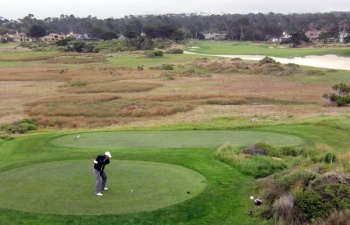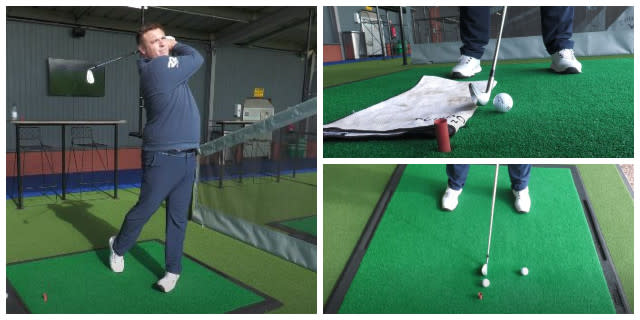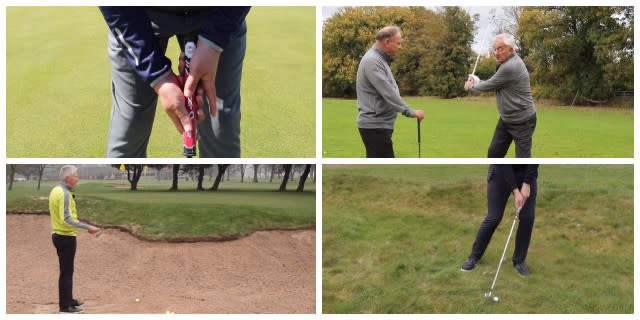Effective Practice - Real Golf
 Golf is played on a golf course. Golf lessons are regularly taken on the driving range. Two quite obvious statements I am sure you would agree. Yet the more I coach, the more I am convinced this needs to be addressed.
Golf is played on a golf course. Golf lessons are regularly taken on the driving range. Two quite obvious statements I am sure you would agree. Yet the more I coach, the more I am convinced this needs to be addressed.
I work with many groups of golfers and often go to the course with them to see how they are playing. From my observation, and feedback from new and experienced golfers, players often cannot take their range game to the golf course.
This may be due to nerves, bad feelings and more. Something has to change! The last time I checked, the only competitive measure of a golfer is how many contacts between club and ball are made starting from the 1st tee and ending up on the 18th green.
I have seen a number of ideas, including:
- Simulating on the range what you want to do on the course, by creating virtual holes
- Trying to recreate pressure situations on the range so you feel more accustomed to this on the course
- Developing plenty of positive memories to look back on
- Creating a consistent pre-shot routine that enables you to feel as comfortable and prepared on the 1st tee as you do on the driving range
These are all positive ideas, but do they equal the full story? I believe these ideas create extra noise and things that the golfer should do, and attention gets taken off the actual task at hand. If these ideas were indeed the ‘magic pill’ that golfers are always looking for, then the top golfers would never feel nervous on the 1st tee. After all, they have done this many times before, have played under the most extreme pressures and have many positive memories. The feelings of nervousness may be better controlled, but I struggle to believe Tiger or Rory are not slightly nervous or fired up as they go to tee #1 of a major.
Here are three of the common problems I encounter and some ideas to help get it right on the course:
#1 Hitting from a mat aligned to one place
Unfortunately, as soon as golfers set foot onto the golf course they come up against all the challenges that course designers put out there to make this game more difficult. Tee boxes are not always pointed straight down the fairway unlike the often square, non-movable shape of a driving range mat. This often leads to misalignment on the course, and as a result, completely different swings to those seen on the range. Now all of a sudden, the great swing you have been developing on the range will only ever lead to shots in the wrong direction, and a new, hybrid-swing full of compensations is the only way to make the golf ball go straight.
Solutions:
- When practicing keep swapping targets so that you are not always just hitting shots aligned with the mat
- On the course, aim at a closer, intermediate target, instead of using a skewed pointing tee-box as your marker and aiming far out into the distance
#2 Having a flat lie in practice
 In the first 3 holes of the most recent round I played, my golfers found they had just 3 shots played from a flat bit of ground. All of these were tee shots! The rest were a combination of uphill, downhill and sidehill lies that needed small adjustments in technique, or some understanding of how the elements will likely affect the shot at hand. If the sum total of your golf practice is on the driving range, be careful; the majority of shots you hit out on the golf course will not be as straightforward as these. This doesn’t mean you need to spend endless hours perfecting each different lie, but just to develop some awareness to feel/see the differences in terrain and know the effect these will have.
In the first 3 holes of the most recent round I played, my golfers found they had just 3 shots played from a flat bit of ground. All of these were tee shots! The rest were a combination of uphill, downhill and sidehill lies that needed small adjustments in technique, or some understanding of how the elements will likely affect the shot at hand. If the sum total of your golf practice is on the driving range, be careful; the majority of shots you hit out on the golf course will not be as straightforward as these. This doesn’t mean you need to spend endless hours perfecting each different lie, but just to develop some awareness to feel/see the differences in terrain and know the effect these will have.
Solutions:
- Take 5 golf balls and place them in different parts of the fairway with varying slopes. Think through what you want to try to do, or the effect the lie may have, before experimenting
- Have a mix in your practice time. It is fine to strike golf balls on the driving range/practice ground, but flat ground is just one potential lie and you will also need to have encountered the other lies you will face on the course in your practice
#3 Learning a technique, not a skill
 When out on the course, I have been pleased to see how well my players did around the greens and in the bunkers. The learning that we have done together has been focused on how the club and ball interacts to produce a shot (see this article for how to play bunker shots and sliding vs. digging) and as a result they had confidence in facing new situations on the course. Instead of learning how to play one shot, these golfers learnt how to control the golf ball in different ways. Learning through guided experimentation what makes a chip shot go low/high, or land soft/roll a lot after landing, gives you the chance to build an adaptable skill-set and not be phased by situations on the course. If you just learn techniques of how to play a ‘chip shot’ you become more rigid and different shots on the course appear a big challenge.
When out on the course, I have been pleased to see how well my players did around the greens and in the bunkers. The learning that we have done together has been focused on how the club and ball interacts to produce a shot (see this article for how to play bunker shots and sliding vs. digging) and as a result they had confidence in facing new situations on the course. Instead of learning how to play one shot, these golfers learnt how to control the golf ball in different ways. Learning through guided experimentation what makes a chip shot go low/high, or land soft/roll a lot after landing, gives you the chance to build an adaptable skill-set and not be phased by situations on the course. If you just learn techniques of how to play a ‘chip shot’ you become more rigid and different shots on the course appear a big challenge.
Solutions:
- Throw 20 golf balls down around a practice green and then try to hit them all close to the hole. You will have to use a variety of high and low shots, probably with different clubs. Experimentation will lead to increased awareness and development of your skill-set and creativity, instead of learning of just one specific technique.
- The best solution? Why not take a playing lesson with your local professional. Get them to play alongside you and be your caddy and help with decision making for your shots and play with you and talk you through all of the things they are considering before playing a shot.
I guarantee these ideas will help you transfer your range game to the course.
Related Content:
Andy Griffiths is a UKPGA member, graduated from the University of Birmingham with the AGMS (Applied Golf Management Studies) degree and holds coaching certifications with the PGA, TGA, TPI Levels 1 & 2.
To find out more about Andy follow him on Twitter @andygriffiths1 , visit his website at www.andygriffithsgolf.com or via Facebook facebook.com/andygriffithsgolf
Related Video
Comments
Andy Griffiths
Andy is a UKPGA member & graduate of the AGMS degree at the University of Birmingham. He's coached in more than 30 countries and travelled and worked with many of the best in the business. His no. 1 desire is to help golfers reach their dreams, and to enjoy the process!
Latest Articles




















